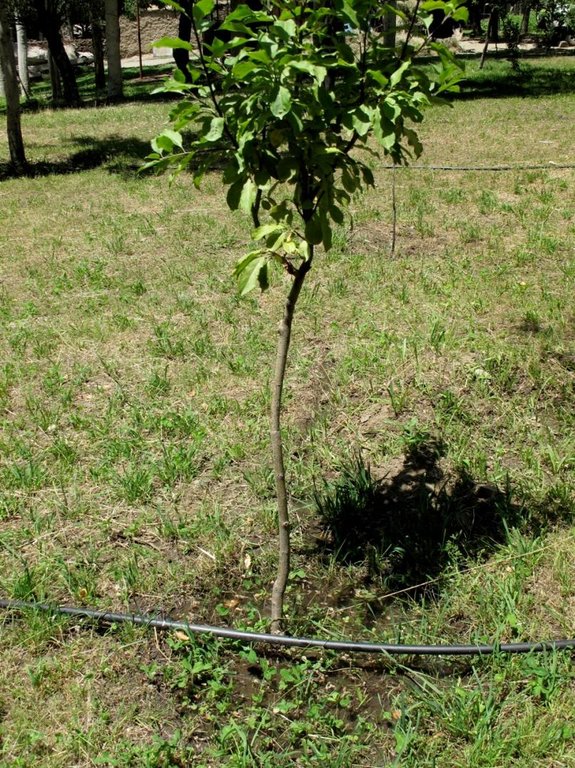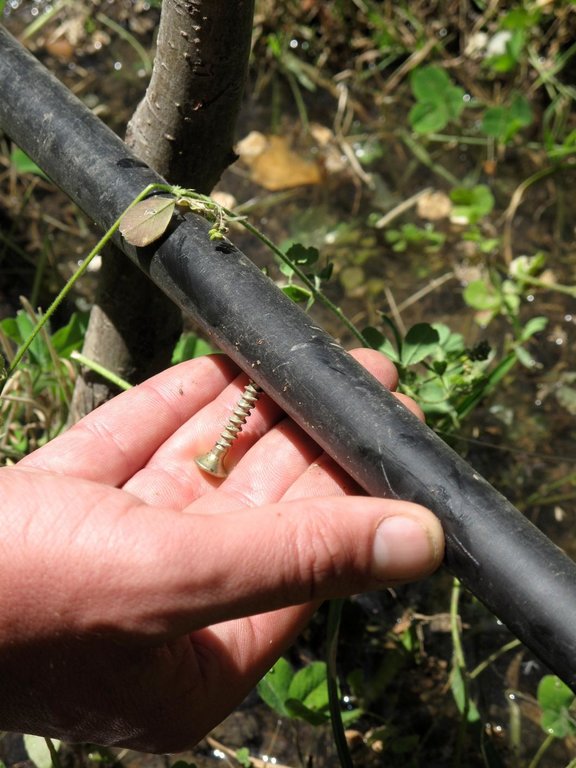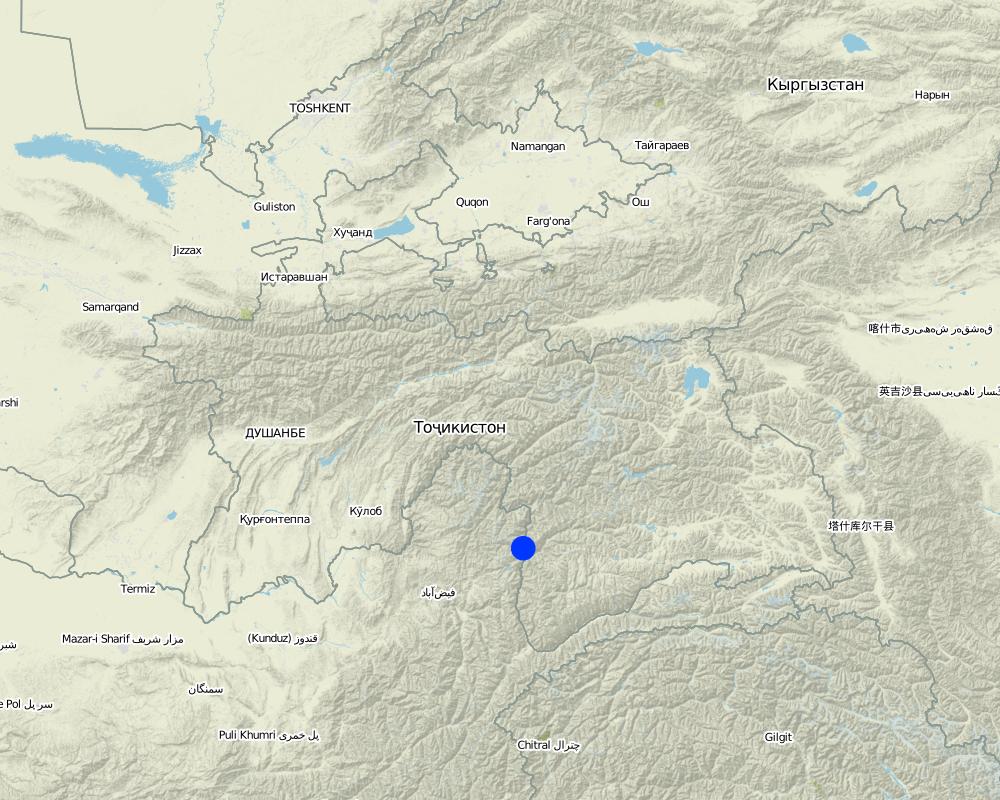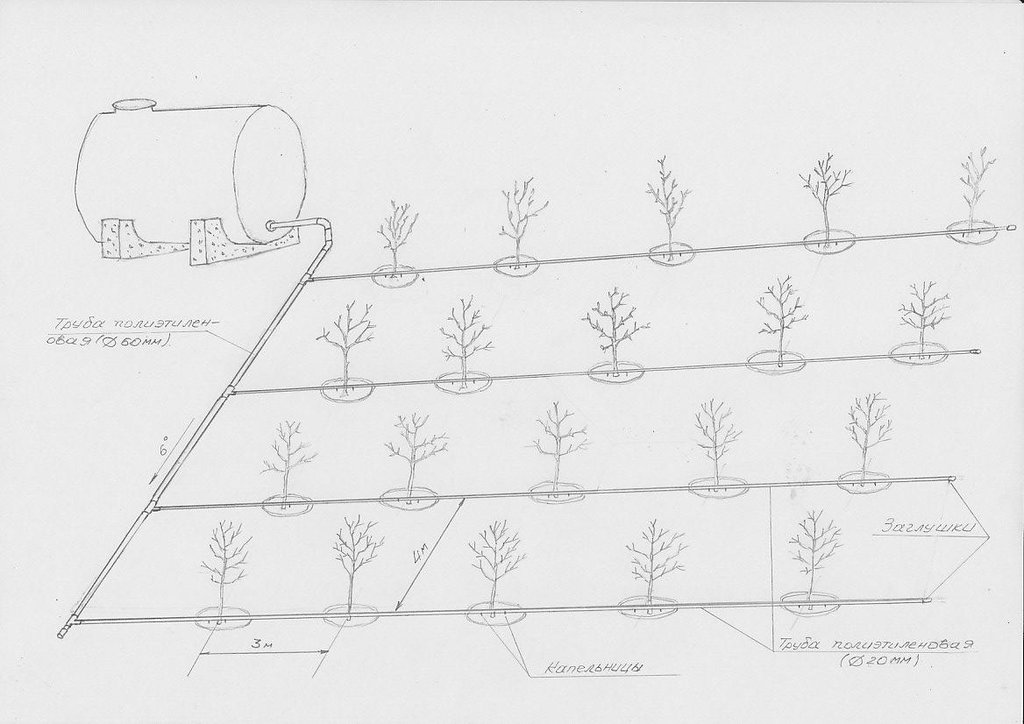Irrigation of orchards by using low cost drip irrigation technique [ทาจิกิสถาน]
- ผู้สร้างสรรค์:
- การอัพเดท:
- ผู้รวบรวม: Aslam Qadamov
- ผู้เรียบเรียง: –
- ผู้ตรวจสอบ: David Streiff, Alexandra Gavilano
Обёрикунии богхо бо истифода аз технологияи обзахиракунии камнарх
technologies_1452 - ทาจิกิสถาน
- บทสรุปทั้งหมดในรูปแบบของ PDF
- บทสรุปทั้งหมดในรูปแบบของ PDF เพื่อพิมพ์
- บทสรุปทั้งหมดในรูปหน้าเว็บ
- บทสรุปทั้งหมด (ไม่มีการจัดเรียง)
- Irrigation of orchards by using low cost drip irrigation technique: 14 มีนาคม 2017 (inactive)
- Irrigation of orchards by using low cost drip irrigation technique: 19 กรกฎาคม 2017 (inactive)
- Irrigation of orchards by using low cost drip irrigation technique: 20 สิงหาคม 2019 (inactive)
- Irrigation of orchards by using low cost drip irrigation technique: 2 พฤศจิกายน 2021 (public)
ดูส่วนย่อย
ขยายทั้งหมด ย่อทั้งหมด1. ข้อมูลทั่วไป
1.2 รายละเอียดที่ติดต่อได้ของผู้รวบรวมและองค์กรที่เกี่ยวข้องในการประเมินและการจัดเตรียมทำเอกสารของเทคโนโลยี
ผู้เชี่ยวชาญ SLM:
Abdulkodirov Adab
MSDSP Aga Khan Foundation
ทาจิกิสถาน
ชื่อขององค์กรซึ่งอำนวยความสะดวกในการทำเอกสารหรือการประเมินเทคโนโลยี (ถ้าเกี่ยวข้อง)
Pamir Biological Institute (Pamir Biological Institute) - ทาจิกิสถานชื่อขององค์กรซึ่งอำนวยความสะดวกในการทำเอกสารหรือการประเมินเทคโนโลยี (ถ้าเกี่ยวข้อง)
Kyrgyzstan Mountain Societies Development Support Programme, Aga Khan Development Network (MSDSP KG) - คีร์กีซสถาน1.3 เงื่อนไขการใช้ข้อมูลที่ได้บันทึกผ่านทาง WOCAT
วันที่เก็บรวบรวมข้อมูล(ภาคสนาม) :
11/04/2011
ผู้รวบรวมและวิทยากรหลักยอมรับเงื่อนไขเกี่ยวกับการใช้ข้อมูลที่ถูกบันทึกผ่านทาง WOCAT:
ใช่
2. การอธิบายลักษณะของเทคโนโลยี SLM
2.1 การอธิบายแบบสั้น ๆ ของเทคโนโลยี
คำจำกัดความของเทคโนโลยี:
Irrigation of a young orchard using locally available and low-cost materials for a drip irrigation system in the Pamir’s arid zone
2.2 การอธิบายแบบละเอียดของเทคโนโลยี
คำอธิบาย:
The system consists of a reservoir and polyethylene irrigation tubes and emitters installed along the rows of trees. Water accumulates in the reservoir during spring and early summer when there is no deficit in irrigation water. During the dry summer months water is then used for drip irrigation. Located in the upper part of the system, the reservoir ensures water pressure in the system. Due to the complex local topography, this irrigation method can be used without water pumps since natural water pressure ensures normal functioning of the system. Even though this water saving technology is quite effective, drip irrigation is rarely used since both the construction and maintenance of the system are quite expensive. With the introduction of this technology into the poor mountain communities of GBAO, the overall objective was to make drip irrigation technology cheaper and more easily available to farmers. The objective was achieved by the use of simple polyethylene irrigation tubes, simple screws instead of expensive emitters, and natural water pressure excluding the construction of a water pump station. Water is dripped directly to the roots of the trees, thus excluding loss of water and soil erosion. Fertilisers can be added directly to the water reservoir. This technology allows increased water savings of 50%, and 90% of fertilisers. During the growing period trees are watered once every 6 days.
Purpose of the Technology: The purpose of this technology is to improve the water supply for fruit orchards during the growing period in the arid conditions of the Pamirs where available water is very limited.
Establishment / maintenance activities and inputs: Steps to implement the technology include the following: dig holes for trees, plant trees, establish water reservoir, lay polyethylene tubes, install emitters and regularly clean irrigation system.
Natural / human environment: The plot is located in an arid zone at the height of 2000m above sea level. It is a high mountain area with typical brown soils and slopes up to 60 degrees steepness. Annual precipitation is quite low and mainly occurs in the autumn and winter period. Summers are extremely dry. The main occupations of the local population include agriculture and cattle breeding.
2.3 รูปภาพของเทคโนโลยี
2.5 ประเทศภูมิภาค หรือสถานที่ตั้งที่เทคโนโลยีได้นำไปใช้และได้รับการครอบคลุมโดยการประเมินนี้
ประเทศ:
ทาจิกิสถาน
ภูมิภาค/รัฐ/จังหวัด:
GBAO
ข้อมูลจำเพาะเพิ่มเติมของสถานที่ตั้ง :
Shugnan
Map
×2.6 วันที่การดำเนินการ
ถ้าไม่รู้ปีที่แน่นอน ให้ระบุวันที่โดยประมาณ:
- น้อยกว่า 10 ปี (ไม่นานนี้)
2.7 คำแนะนำของเทคโนโลยี
ให้ระบุว่าเทคโนโลยีถูกแนะนำเข้ามาอย่างไร:
- ทางโครงการหรือจากภายนอก
ความคิดเห็น (ประเภทของโครงการ เป็นต้น) :
the project was implemented in 2006
3. การจัดประเภทของเทคโนโลยี SLM
3.1 วัตถุประสงค์หลักของเทคโนโลยี
- adapt to enviroment
3.2 ประเภทของการใช้ที่ดินในปัจจุบันที่ได้นำเทคโนโลยีไปใช้

พื้นที่ปลูกพืช
- การปลูกไม้ยืนต้น ไม้พุ่ม
พืชหลัก (พืชเศรษฐกิจและพืชอาหาร):
major food crop: apple, apricot, walnut
แสดงความคิดเห็น:
Major land use problems (compiler’s opinion): lack of water, soil erosion, reduction of yield, reduction of soil fertility
Major land use problems (land users’ perception): lack of irrigation water, reduction of yield
Future (final) land use (after implementation of SLM Technology): Cropland: Ct: Tree and shrub cropping
ถ้าการใช้ที่ดินมีการเปลี่ยนแปลงเนื่องมาจากการนำเทคโนโลยีไปปฏิบัติใช้ ให้ระบุการใช้ที่ดินก่อนนำเทคโนโลยีไปปฏิบัติใช้:
Cropland: Ct: Tree and shrub cropping
3.3 ข้อมูลเพิ่มเติมเกี่ยวกับการใช้ที่ดิน
การใช้น้ำของที่ดินที่มีการใช้เทคโนโลยีอยู่:
- การชลประทานแบบเต็มรูปแบบ
จำนวนของฤดูเพาะปลูกต่อปี:
- 1
ระบุ:
Longest growing period in days: 190Longest growing period from month to month: from April to October
3.4 กลุ่ม SLM ที่ตรงกับเทคโนโลยีนี้
- การจัดการด้านชลประทาน (รวมถึงการลำเลียงส่งน้ำ การระบายน้ำ)
3.5 กระจายตัวของเทคโนโลยี
ระบุการกระจายตัวของเทคโนโลยี:
- กระจายไปอย่างสม่ำเสมอในพื้นที่
ถ้าหากว่าเทคโนโลยีได้มีการกระจายออกไปอย่างสม่ำเสมอในพื้นที่ ให้ระบุปริมาณพื้นที่ที่ได้รับการครอบคลุมถึง:
- < 0.1 ตร.กม.(10 เฮกตาร์)
แสดงความคิดเห็น:
0.01 ha
3.6 มาตรการ SLM ที่ประกอบกันเป็นเทคโนโลยี

มาตรการจัดการพืช
- A1: พืช/สิ่งปกคลุมดิน

มาตรการอนุรักษ์ด้วยวิธีพืช
- V1: ต้นไม้และพุ่มไม้คลุมดิน

มาตรการอนุรักษ์ด้วยการจัดการ
- M4: การเปลี่ยนแปลงช่วงเวลาให้เหมาะแก่การทำกิจกรรม
แสดงความคิดเห็น:
Main measures: vegetative measures
Secondary measures: agronomic measures
Type of vegetative measures: aligned: -linear
3.7 รูปแบบหลักของการเสื่อมโทรมของที่ดินที่ได้รับการแก้ไขโดยเทคโนโลยี

การเสื่อมโทรมของดินทางด้านชีวภาพ
- Bc (Reduction of vegetation cover): การลดลงของจำนวนพืชที่ปกคลุมดิน

การเสื่อมโทรมของน้ำ
- Ha (Aridification): การเกิดความแห้งแล้ง
แสดงความคิดเห็น:
Main type of degradation addressed: Bc: reduction of vegetation cover, Ha: aridification
Main causes of degradation: soil management, crop management (annual, perennial, tree/shrub), change in temperature, change of seasonal rainfall
Secondary causes of degradation: over abstraction / excessive withdrawal of water (for irrigation, industry, etc.), droughts, population pressure, poverty / wealth
3.8 การป้องกัน การลดลง หรือการฟื้นฟูความเสื่อมโทรมของที่ดิน
ระบุเป้าหมายของเทคโนโลยีกับความเสื่อมโทรมของที่ดิน:
- ป้องกันความเสื่อมโทรมของที่ดิน
- ลดความเสื่อมโทรมของดิน
แสดงความคิดเห็น:
Main goals: prevention of land degradation
Secondary goals: mitigation / reduction of land degradation, rehabilitation / reclamation of denuded land
4. ข้อมูลจำเพาะด้านเทคนิค กิจกรรมการนำไปปฏิบัติใช้ ปัจจัยนำเข้า และค่าใช้จ่าย
4.1 แบบแปลนทางเทคนิคของเทคโนโลยี
4.2 ข้อมูลจำเพาะด้านเทคนิคและการอธิบายแบบแปลนทางเทคนิค
The system consists of a reservoir and polyethylene irrigation tubes and emitters installed along the rows of trees.
Technical knowledge required for field staff / advisors: moderate
Technical knowledge required for land users: moderate
Main technical functions: stabilisation of soil (eg by tree roots against land slides), increase / maintain water stored in soil, water harvesting / increase water supply
Secondary technical functions: improvement of ground cover, increase in organic matter, increase in nutrient availability (supply, recycling,…), water spreading, increase of biomass (quantity), promotion of vegetation species and varieties (quality, eg palatable fodder)
Aligned: -linear
Vegetative material: F : fruit trees / shrubs
Number of plants per (ha): 400
Vertical interval between rows / strips / blocks (m): 1
Spacing between rows / strips / blocks (m): 3
Vertical interval within rows / strips / blocks (m): 3
Fruit trees / shrubs species: apricot, peach, european walnut, apple
Perennial crops species: alfalfa
Slope (which determines the spacing indicated above): 8.00%
4.3 ข้อมูลทั่วไปเกี่ยวกับการคำนวณปัจจัยนำเข้าและค่าใช้จ่าย
อื่นๆ หรือสกุลเงินประจำชาติ (ระบุ):
Tajik Somony
ระบุอัตราแลกเปลี่ยนจากดอลลาร์สหรัฐเป็นสกุลเงินท้องถิ่น (ถ้าเกี่ยวข้อง) คือ 1 เหรียญสหรัฐ =:
4.45
ระบุค่าเฉลี่ยของค่าจ้างในการจ้างแรงงานต่อวัน:
3.00
4.4 กิจกรรมเพื่อการจัดตั้ง
| กิจกรรม | ประเภทของมาตรการ | ช่วงเวลาดำเนินการ | |
|---|---|---|---|
| 1. | tree planting | ด้วยวิธีพืช | first year |
| 2. | mounting of drip irrigation system | ด้วยวิธีพืช | before planting |
4.5 ค่าใช้จ่ายของปัจจัยนำเข้าที่จำเป็นสำหรับการจัดตั้ง
| ปัจจัยนำเข้า | หน่วย | ปริมาณ | ค่าใช้จ่ายต่อหน่วย | ค่าใช้จ่ายทั้งหมดต่อปัจจัยนำเข้า | %ของค่าใช้จ่ายที่ก่อให้เกิดขึ้นโดยผู้ใช้ที่ดิน | |
|---|---|---|---|---|---|---|
| แรงงาน | Tree planting | Persons/day | 2.0 | 11.0 | 22.0 | 100.0 |
| แรงงาน | Mounting of drip irrigation system | Persons/day | 5.0 | 25.2 | 126.0 | |
| อุปกรณ์ | Tools | pieces | 5.0 | 1.2 | 6.0 | 100.0 |
| อุปกรณ์ | Other Tools | pieces | 5.0 | 2.2 | 11.0 | |
| อุปกรณ์ | Polyethylene tube | meters | 2200.0 | 0.445454545 | 980.0 | |
| อุปกรณ์ | Watertank | pieces | 1.0 | 600.0 | 600.0 | |
| วัสดุด้านพืช | Tree seedlings | pieces | 360.0 | 0.675 | 243.0 | 100.0 |
| ปุ๋ยและสารฆ่า/ยับยั้งการเจริญเติบโตของสิ่งมีชีวิต (ไบโอไซด์) | Fertilizer | kg | 10.0 | 1.7 | 17.0 | 100.0 |
| ค่าใช้จ่ายทั้งหมดของการจัดตั้งเทคโนโลยี | 2005.0 | |||||
แสดงความคิดเห็น:
Duration of establishment phase: 1 month(s)
4.6 การบำรุงรักษาสภาพหรือกิจกรรมที่เกิดขึ้นเป็นประจำ
| กิจกรรม | ประเภทของมาตรการ | ช่วงระยะเวลา/ความถี่ | |
|---|---|---|---|
| 1. | sanitary cutting of trees | ด้วยวิธีพืช | every 3-5 years |
| 2. | hay harvest | ด้วยวิธีพืช | three time per year |
| 3. | unclogging the irrigation tubes | ด้วยวิธีพืช | every year |
4.7 ค่าใช้จ่ายของปัจจัยนำเข้าและกิจกรรมที่เกิดขึ้นเป็นประจำที่ต้องการการบำรุงรักษา (ต่อปี)
| ปัจจัยนำเข้า | หน่วย | ปริมาณ | ค่าใช้จ่ายต่อหน่วย | ค่าใช้จ่ายทั้งหมดต่อปัจจัยนำเข้า | %ของค่าใช้จ่ายที่ก่อให้เกิดขึ้นโดยผู้ใช้ที่ดิน | |
|---|---|---|---|---|---|---|
| แรงงาน | Sanitary cutting of trees | Persons/day | 0.6 | 16.66667 | 10.0 | 100.0 |
| แรงงาน | Hay harvest | Persons/day | 1.0 | 9.0 | 9.0 | 100.0 |
| แรงงาน | Unclogging the irrigation tubes | Persons/day | 1.0 | 11.0 | 11.0 | |
| อุปกรณ์ | Tools (Scissors) | pieces | 2.0 | 2.5 | 5.0 | 100.0 |
| อุปกรณ์ | Tool for harvesting | pieces | 1.0 | 2.0 | 2.0 | 100.0 |
| อุปกรณ์ | Tools for unclogging tubes | pieces | 2.0 | 2.25 | 4.5 | 100.0 |
| อุปกรณ์ | Polyethylene tube | meters | 56.0 | 0.445454545 | 24.95 | 100.0 |
| อุปกรณ์ | Water tank | repair | 1.0 | 10.0 | 10.0 | 100.0 |
| วัสดุด้านพืช | Seedlings tree replacement | pieces | 15.0 | 0.675 | 10.13 | 100.0 |
| ปุ๋ยและสารฆ่า/ยับยั้งการเจริญเติบโตของสิ่งมีชีวิต (ไบโอไซด์) | Fertilizer | kg | 10.0 | 1.7 | 17.0 | 100.0 |
| ค่าใช้จ่ายทั้งหมดของการบำรุงรักษาสภาพเทคโนโลยี | 103.58 | |||||
แสดงความคิดเห็น:
For creation of drip irrigation system on a plot of 1 ha (May 2011)
4.8 ปัจจัยสำคัญที่สุดที่มีผลกระทบต่อค่าใช้จ่าย
ปัจจัยสำคัญที่สุดที่มีผลกระทบต่อค่าใช้จ่ายต่างๆ:
equipment for irrigation system (polyethylene tubes)
5. สิ่งแวดล้อมทางธรรมชาติและของมนุษย์
5.1 ภูมิอากาศ
ฝนประจำปี
- < 250 ม.ม.
- 251-500 ม.ม.
- 501-750 ม.ม.
- 751-1,000 ม.ม.
- 1,001-1,500 ม.ม.
- 1,501-2,000 ม.ม.
- 2,001-3,000 ม.ม.
- 3,001-4,000 ม.ม.
- > 4,000 ม.ม.
ข้อมูลจำเพาะ/ความคิดเห็นเรื่องปริมาณน้ำฝน:
260mm per year, winter summer rains. Length of dry period is about 120 days.
เขตภูมิอากาศเกษตร
- แห้งแล้ง
Thermal climate class: temperate. 2 mounth below 5°C and 6 mounth above 10°C
5.2 สภาพภูมิประเทศ
ค่าเฉลี่ยความลาดชัน:
- ราบเรียบ (0-2%)
- ลาดที่ไม่ชัน (3-5%)
- ปานกลาง (6-10%)
- เป็นลูกคลื่น (11-15%)
- เป็นเนิน (16-30%)
- ชัน (31-60%)
- ชันมาก (>60%)
ธรณีสัณฐาน:
- ที่ราบสูง/ที่ราบ
- สันเขา
- ไหล่เขา
- ไหล่เนินเขา
- ตีนเนิน
- หุบเขา
ระดับความสูง:
- 0-100 เมตร
- 101-500 เมตร
- 501-1,000 เมตร
- 1,001-1,500 เมตร
- 1,501-2,000 เมตร
- 2,001-2,500 เมตร
- 2,501-3,000 เมตร
- 3,001-4,000 เมตร
- > 4,000 เมตร
ความคิดเห็นและข้อมูลจำเพาะเพิ่มเติมเรื่องสภาพภูมิประเทศ:
Altitudinal zone is 2100m above sea level
5.3 ดิน
ค่าเฉลี่ยความลึกของดิน:
- ตื้นมาก (0-20 ซ.ม.)
- ตื้น (21-50 ซ.ม.)
- ลึกปานกลาง (51-80 ซ.ม.)
- ลึก (81-120 ซ.ม.)
- ลึกมาก (>120 ซ.ม.)
เนื้อดิน (ดินชั้นบน):
- ปานกลาง (ดินร่วน ทรายแป้ง)
อินทรียวัตถุในดิน:
- ต่ำ (<1%)
(ถ้ามี) ให้แนบคำอธิบายเรื่องดินแบบเต็มหรือระบุข้อมูลที่มีอยู่ เช่น ชนิดของดิน ค่า pH ของดินหรือความเป็นกรดของดิน ความสามารถในการแลกเปลี่ยนประจุบวก ไนโตรเจน ความเค็ม เป็นต้น:
Soil texture is about 40% silt
Soil fertility is medium
Soil drainage / infiltration is good
Soil water storage capacity is medium
5.4 ความเป็นประโยชน์และคุณภาพของน้ำ
ระดับน้ำใต้ดิน:
<5 เมตร
น้ำไหลบ่าที่ผิวดิน:
ปานกลาง
คุณภาพน้ำ (ที่ยังไม่ได้บำบัด):
เป็นน้ำเพื่อการดื่มที่ดี
5.5 ความหลากหลายทางชีวภาพ
ความหลากหลายทางชนิดพันธุ์:
- ปานกลาง
5.6 ลักษณะของผู้ใช้ที่ดินที่นำเทคโนโลยีไปปฏิบัติใช้
แนวทางการตลาดของระบบการผลิต:
- เพื่อการยังชีพ (หาเลี้ยงตนเอง)
- ทำการค้า/การตลาด
รายได้ที่มาจากนอกฟาร์ม:
- 10-50% ของรายได้ทั้งหมด
ระดับของความมั่งคั่งโดยเปรียบเทียบ:
- จน
- พอมีพอกิน
เป็นรายบุคคล/ครัวเรือน:
- เป็นรายบุคคล/ครัวเรือน
ระดับของการใช้เครื่องจักรกล:
- งานที่ใช้แรงกาย
เพศ:
- หญิง
- ชาย
ระบุลักษณะอื่นๆที่เกี่ยวข้องของผู้ใช้ที่ดิน:
Land users applying the Technology are mainly common / average land users
Population density: 10-50 persons/km2
Annual population growth: 0.5% - 1%
40% of the land users are average wealthy and own 30% of the land.
60% of the land users are poor and own 70% of the land.
Off-farm income specification: In dry season the harvest is about 20 - 30% higher as compared with the farmers which did not use the technology
5.7 พื้นที่เฉลี่ยของที่ดินที่เป็นเจ้าของหรือเช่าโดยผู้ใช้ที่ดินที่นำเทคโนโลยีไปปฏิบัติใช้
- < 0.5 เฮกตาร์
- 0.5-1 เฮกตาร์
- 1-2 เฮกตาร์
- 2-5 เฮกตาร์
- 5-15 เฮกตาร์
- 15-50 เฮกตาร์
- 50-100 เฮกตาร์
- 100-500 เฮกตาร์
- 500-1,000 เฮกตาร์
- 1,000-10,000 เฮกตาร์
- >10,000 เฮกตาร์
พิจารณาว่าเป็นขนาดเล็ก กลาง หรือขนาดใหญ่ (ซึ่งอ้างอิงถึงบริบทระดับท้องถิ่น):
- ขนาดเล็ก
5.8 กรรมสิทธิ์ในที่ดิน สิทธิในการใช้ที่ดินและสิทธิในการใช้น้ำ
กรรมสิทธิ์ในที่ดิน:
- เป็นแบบชุมชนหรือหมู่บ้าน
สิทธิในการใช้ที่ดิน:
- รายบุคคล
สิทธิในการใช้น้ำ:
- เกี่ยวกับชุมชน (ถูกจัดระเบียบ)
5.9 การเข้าถึงบริการและโครงสร้างพื้นฐาน
สุขภาพ:
- จน
- ปานกลาง
- ดี
การศึกษา:
- จน
- ปานกลาง
- ดี
ความช่วยเหลือทางด้านเทคนิค:
- จน
- ปานกลาง
- ดี
การจ้างงาน (เช่น ภายนอกฟาร์ม):
- จน
- ปานกลาง
- ดี
ตลาด:
- จน
- ปานกลาง
- ดี
พลังงาน:
- จน
- ปานกลาง
- ดี
ถนนและการขนส่ง:
- จน
- ปานกลาง
- ดี
น้ำดื่มและการสุขาภิบาล:
- จน
- ปานกลาง
- ดี
บริการด้านการเงิน:
- จน
- ปานกลาง
- ดี
6. ผลกระทบและสรุปคำบอกกล่าว
6.1 ผลกระทบในพื้นที่ดำเนินการ (On-site) จากการใช้เทคโนโลยี
ผลกระทบทางด้านเศรษฐกิจและสังคม
การผลิต
การผลิตพืชผล
จำนวนก่อน SLM:
45kg per ha
หลังจาก SLM:
80kg per ha
แสดงความคิดเห็น/ระบุ:
water availability increase production of fruits
การผลิตพืชที่ใช้เลี้ยงปศุสัตว์
จำนวนก่อน SLM:
5 centner/ha
หลังจาก SLM:
20 centner/ha
แสดงความคิดเห็น/ระบุ:
grass between rows used for fodder
คุณภาพพืชที่ใช้เลี้ยงปศุสัตว์
จำนวนก่อน SLM:
bad
หลังจาก SLM:
high
แสดงความคิดเห็น/ระบุ:
before natural grass - after alfa alfa
การผลิตสัตว์
จำนวนก่อน SLM:
2- 5per hose
หลังจาก SLM:
6-15 per hose
แสดงความคิดเห็น/ระบุ:
increase of fodder production stimulate livestock development
การผลิตไม้
จำนวนก่อน SLM:
0.5 m3/hose
หลังจาก SLM:
1-5m3/hose
แสดงความคิดเห็น/ระบุ:
sanitary cutting of tress
การเสี่ยงต่อความล้มเหลวในการผลิต
จำนวนก่อน SLM:
0
หลังจาก SLM:
100%
แสดงความคิดเห็น/ระบุ:
increased water availability
พื้นที่สำหรับการผลิต
จำนวนก่อน SLM:
10%
หลังจาก SLM:
70%
แสดงความคิดเห็น/ระบุ:
technology helps to use steep slopes
รายได้และค่าใช้จ่าย
ค่าใช่จ่ายของปัจจัยการผลิตทางการเกษตร
จำนวนก่อน SLM:
0
หลังจาก SLM:
50%
รายได้จากฟาร์ม
จำนวนก่อน SLM:
10%
หลังจาก SLM:
80%
แสดงความคิดเห็น/ระบุ:
increased harvest
ผลกระทบด้านสังคมวัฒนธรรมอื่น ๆ
ความมั่นคงด้านอาหาร / พึ่งตนเองได้
จำนวนก่อน SLM:
0
การบรรเทาความขัดแย้ง
จำนวนก่อน SLM:
50%
หลังจาก SLM:
0%
แสดงความคิดเห็น/ระบุ:
decreased conflict related to irrigation water use
สถานการณ์ของกลุ่มด้อยโอกาส ทางด้านสังคมและเศรษฐกิจ
จำนวนก่อน SLM:
0
หลังจาก SLM:
50%
แสดงความคิดเห็น/ระบุ:
increased incomes of poor farmers
Livelihoods and human well-being
แสดงความคิดเห็น/ระบุ:
After the implementation of the technology the households were protected from negative influence of dry season.
ผลกระทบด้านนิเวศวิทยา
วัฐจักรน้ำหรือน้ำบ่า
ปริมาณน้ำ
จำนวนก่อน SLM:
10%
หลังจาก SLM:
60%
การเก็บเกี่ยวหรือการกักเก็บน้ำ
จำนวนก่อน SLM:
0%
หลังจาก SLM:
100%
น้ำไหลบ่าที่ผิวดิน
จำนวนก่อน SLM:
100%
หลังจาก SLM:
0%
แสดงความคิดเห็น/ระบุ:
all the water can be absorbed by soil
การระเหย
จำนวนก่อน SLM:
0
หลังจาก SLM:
10%
แสดงความคิดเห็น/ระบุ:
transpiration of trees and grass
ดิน
ความชื้นในดิน
จำนวนก่อน SLM:
0%
หลังจาก SLM:
80%
แสดงความคิดเห็น/ระบุ:
during the dry season
สิ่งปกคลุมดิน
จำนวนก่อน SLM:
0%
หลังจาก SLM:
20%
การสูญเสียดิน
การเกิดแผ่นแข็งที่ผิวดิน /การเกิดชั้นดาน
การอัดแน่นของดิน
ความหลากหลายทางชีวภาพของพืชและสัตว์
มวลชีวภาพ/เหนือดินชั้น C
ความหลากหลายทางชีวภาพของพืช
ความหลากหลายของสัตว์
ผลกระทบด้านนิเวศวิทยาอื่น ๆ
Hazards towards adverse events
จำนวนก่อน SLM:
0%
หลังจาก SLM:
100%
แสดงความคิดเห็น/ระบุ:
reduced dry season effect
6.2 ผลกระทบนอกพื้นที่ดำเนินการ (Off-site) จากการใช้เทคโนโลยี
น้ำที่ใช้ประโยชน์ได้
จำนวนก่อน SLM:
0%
หลังจาก SLM:
50%
6.3 การเผชิญและความตอบสนองของเทคโนโลยีต่อการเปลี่ยนแปลงสภาพภูมิอากาศที่ค่อยเป็นค่อยไป และสภาพรุนแรงของภูมิอากาศ / ภัยพิบัติ (ที่รับรู้ได้โดยผู้ใช้ที่ดิน)
การเปลี่ยนแปลงสภาพภูมิอากาศที่ค่อยเป็นค่อยไป
การเปลี่ยนแปลงสภาพภูมิอากาศที่ค่อยเป็นค่อยไป
| ฤดู | ประเภทของการเปลี่ยนแปลงสภาพภูมิอากาศที่ค่อยเป็นค่อยไป และสภาพรุนแรงของภูมิอากาศ | เทคโนโลยีมีวิธีการรับมืออย่างไร | |
|---|---|---|---|
| อุณหภูมิประจำปี | เพิ่มขึ้น | ดี |
สภาพรุนแรงของภูมิอากาศ (ภัยพิบัติ)
ภัยพิบัติทางอุตุนิยมวิทยา
| เทคโนโลยีมีวิธีการรับมืออย่างไร | |
|---|---|
| พายุฝนประจำท้องถิ่น | ดี |
| พายุลมประจำท้องถิ่น | ดี |
ภัยพิบัติจากสภาพภูมิอากาศ
| เทคโนโลยีมีวิธีการรับมืออย่างไร | |
|---|---|
| ภัยจากฝนแล้ง | ไม่ค่อยดี |
ภัยพิบัติจากน้ำ
| เทคโนโลยีมีวิธีการรับมืออย่างไร | |
|---|---|
| น้ำท่วมตามปกติ (แม่น้ำ) | ไม่ค่อยดี |
ผลลัพธ์ตามมาที่เกี่ยวข้องกับภูมิอากาศอื่น ๆ
ผลลัพธ์ตามมาที่เกี่ยวข้องกับภูมิอากาศอื่น ๆ
| เทคโนโลยีมีวิธีการรับมืออย่างไร | |
|---|---|
| ช่วงการปลูกพืชที่ลดลงมา | ดี |
6.4 การวิเคราะห์ค่าใช้จ่ายและผลประโยชน์ที่ได้รับ
ผลประโยชน์ที่ได้รับเปรียบเทียบกับค่าใช้จ่ายในการจัดตั้งเป็นอย่างไร (จากมุมมองของผู้ใช้ที่ดิน)
ผลตอบแทนระยะสั้น:
ด้านลบเล็กน้อย
ผลตอบแทนระยะยาว:
ด้านบวก
ผลประโยชน์ที่ได้รับเปรียบเทียบกับค่าใช้จ่ายในการบำรุงรักษาหรือต้นทุนที่เกิดขึ้นซ้ำอีก เป็นอย่างไร (จากมุมมองของผู้ใช้ที่ดิน)
ผลตอบแทนระยะสั้น:
เป็นกลางหรือสมดุล
ผลตอบแทนระยะยาว:
ด้านบวก
แสดงความคิดเห็น:
Increase of irrigation water availability will improve agricultural production and cover all the expenses that were needed for the establishment of the irrigation system
6.5 การปรับตัวของเทคโนโลยี
- มากกว่า 50%
ถ้ามีข้อมูลให้บอกปริมาณด้วย (จำนวนของครัวเรือนหรือครอบคลุมพื้นที่):
18 households (area is 10 ha)
จากทั้งหมดที่ได้รับเทคโนโลยีเข้ามามีจำนวนเท่าใดที่ทำแบบทันที โดยไม่ได้รับการจูงใจด้านวัสดุหรือการเงินใด ๆ:
- 10-50%
แสดงความคิดเห็น:
80% of land user families have adopted the Technology with external material support
15 land user families have adopted the Technology with external material support
20% of land user families have adopted the Technology without any external material support
3 land user families have adopted the Technology without any external material support
There is a little trend towards spontaneous adoption of the Technology
Comments on adoption trend: some land users have already adopted the system
6.7 จุดแข็ง / ข้อได้เปรียบ / โอกาสของเทคโนโลยี
| จุดแข็ง / ข้อได้เปรียบ / โอกาสในทัศนคติของผู้ใช้ที่ดิน |
|---|
| Increase water resources for irrigation of orchards |
| จุดแข็ง / ข้อได้เปรียบ / โอกาสในทัศนคติของผู้รวบรวมหรือวิทยากรหลัก |
|---|
| Increases water saving up to 50% |
| Opportunity to irrigate orchards during droughts and dry spells (when there is no irrigation water available) |
| Opportunity to apply this technology on steep slopes |
|
Reservoir can be filled with rainwater How can they be sustained / enhanced? through installation of rainwater harvesting system |
6.8 จุดอ่อน / ข้อเสียเปรียบ / ความเสี่ยงของเทคโนโลยีและวิธีการแก้ไข
| จุดอ่อน / ข้อเสียเปรียบ / ความเสี่ยงในทัศนคติของผู้รวบรวมหรือวิทยากรหลัก | มีวิธีการแก้ไขได้อย่างไร |
|---|---|
| The system has to be regularly cleaned from sediments | use filters to clean water from sediments |
ลิงก์และโมดูล
ขยายทั้งหมด ย่อทั้งหมดลิงก์
ไม่มีลิงก์
โมดูล
ไม่มีโมดูล






